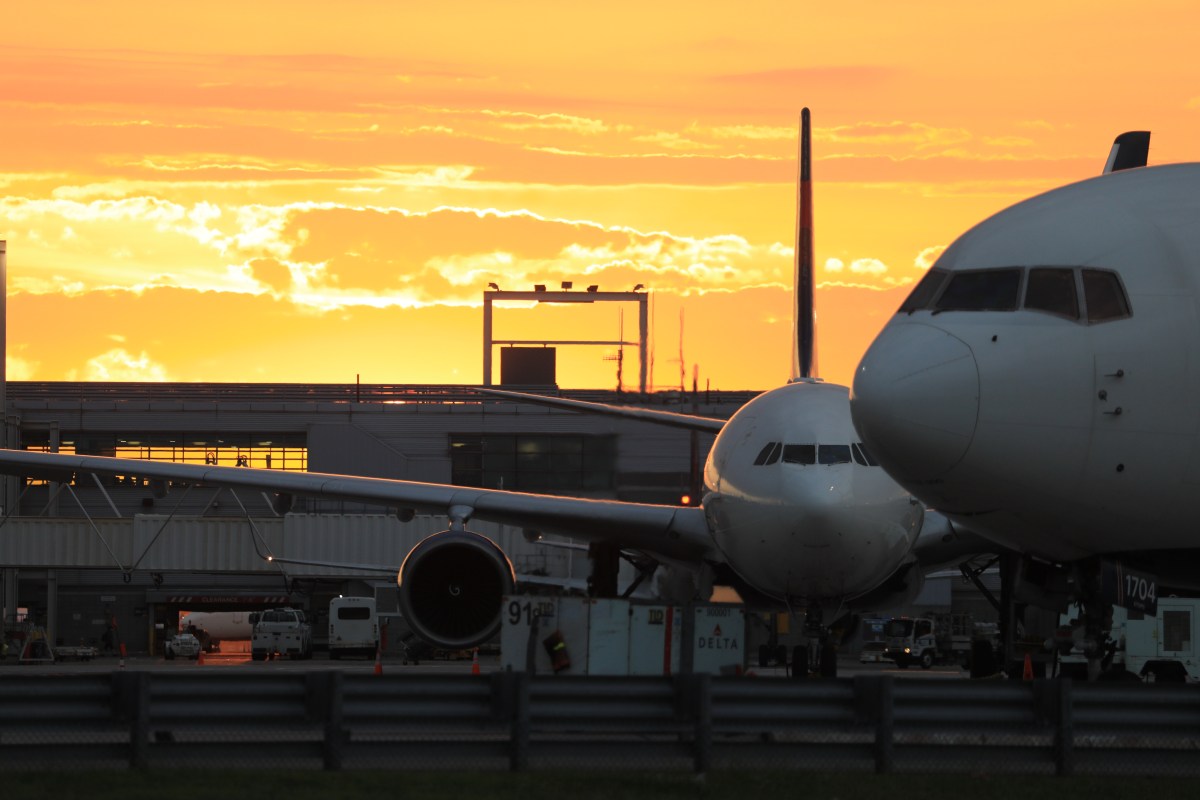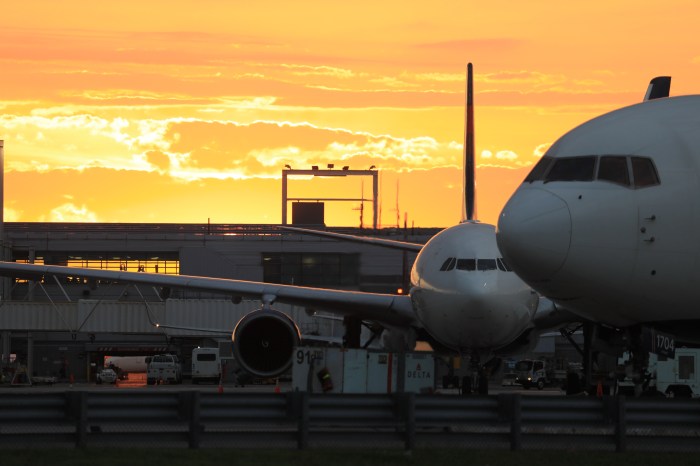By Julie Shapiro
Local activists are cautiously optimistic about a newly approved plan for the decontamination of the former Deutsche Bank building.
In the plan, announced Feb. 7, the Lower Manhattan Development Corporation committed to clean up the entire building before continuing to demolish it, a course community members have been advocating for months.
“It’s a wonderful thing that L.M.D.C. has stepped up,” said Kimberly Flynn, head of 9/11 Environmental Action. “This is the most critical decision in terms of reducing the risks going forward.”
The plan is the first abatement plan that the L.M.D.C. has released for the building since the fire last August that killed two firefighters. Contaminants from the World Trade Center collapse remain in the building, and before the fire, the L.M.D.C. was simultaneously removing the contaminants and knocking down floors. Twenty-six of the building’s 40 stories remain, and at least half of them may still be contaminated.
The plan only deals with the abatement of the building, so prior to deconstruction, the L.M.D.C. will have to submit — and receive approval for — a demolition plan. At a recent meeting, David Emil, president of the L.M.D.C., said the agency would use the time during abatement to create a deconstruction plan.
The L.M.D.C. hopes the building will be down by the end of the year but in a press release did not say when the abatement would begin, how long it would take, or when the decontamination plan will be ready.
An L.M.D.C. spokesperson declined to comment.
Over the years, every step of the dismantling of the Deutsche Bank building has taken months, if not years longer than predictions, including the approval of the original abatement and deconstruction plan. If abatement finishes before the decontamination plan is approved, it is possible that work could reach another standstill, as happened this fall.
But for now, community leaders aren’t focusing on that scenario.
“I’m sure they’re going full force on the deconstruction plan,” said Catherine McVay Hughes, chairperson of the Community Board 1 World Trade Center Redevelopment Committee. “I want to be optimistic — we all want to be optimistic.”
Flynn was pleased by much of what she saw in the L.M.D.C.’s plan.
“The specifics are very reassuring,” she said. “This is obviously the result of detailed negotiation where a lot of issues have been nailed down.”
In the plan, the L.M.D.C. makes many references to regulatory agencies and commits to follow their protocols, including those that are enacted in the future. The L.M.D.C. also promises to respond to concerns of those agencies. In the months and years leading up to the fire, the Environmental Protection Agency and others expressed safety concerns to the L.M.D.C. without receiving a response, Flynn said, an assertion backed by many others in the community.
For the first time, the L.M.D.C. plan also lays out a clear chain of command and responsibility. One of the biggest questions after the fire was who had been responsible for safety. Going forward, the answer is unequivocal: “The general contractor has total site safety responsibility,” the L.M.D.C.’s plan sates, at the end of a long list of specific safety procedures the general contractor must follow. The general contractor is Bovis Lend Lease, which is also the general contractor on the Trump Soho condo-hotel, where a worker was killed last month. Bovis is now working with LVI Environmental Services, Inc. at 130 Liberty St.
“We’ve come a long way from the vague responses L.M.D.C. gave to so many community questions about safety: ‘We’re cooperating with the regulators,’ which was repeated like a mantra,” Flynn said. “These documents begin to spell out what that cooperation looks like going forward.”
The document also includes safety measures Avi Schick, the L.M.D.C.’s chairperson, had previously mentioned: frequent standpipe inspections, an alarm system for potential standpipe breaches, a 24-hour presence at the site, a protected pathway out of the building in case of emergency, storage of combustible materials in a vault, switches to deactivate the negative air pressure required for decontamination and lockboxes on the site containing updated floor plans.
For Flynn and other activists, the biggest hole in the L.M.D.C.’s new plan is community notification, which she says is still inadequate. Flynn wants to see measures like reverse 911, person-to-person calls and emergency training for residents, office workers and school personnel.
In terms of notification, Hughes, of C.B. 1, was surprised not to find out about the new abatement plan directly from the L.M.D.C. “One of the things we’ve been asking for is a clear and transparent process,” she said. “Deutsche Bank is clearly a building that demands an open process. We need to have an open meeting on this so people can find out what’s going on.”
The L.M.D.C. declined an invitation to attend the W.T.C. Committee Monday evening.
Dave Newman, industrial hygienist with New York Committee for Occupational Safety and Health, said the L.M.D.C. was disingenuous in not releasing details of the plan earlier, since it has clearly been under discussion for months.
“They’ve kept all of this a secret from the community,” Newman said. “There’s no transparency, no give and take, and that continues to be unacceptable.”
Newman was most concerned about the plan’s details, which he said show sloppy planning. For example, some parts of the plan prohibit workers from using elevators, while other parts say elevators will be used to remove material from the building, Newman said.
But on the whole, activists who have been closely following the L.M.D.C.’s decisions said the big picture looks good.
Rob Spencer, director of media services for the Organization of Staff Analysts union, called the decision to decouple a victory. “It’s an encouraging sequence of events,” Spencer said. “I’m just glad to see they’re taking the concerns of regulators seriously.”
Esther Regelson, resident of 109 Washington St., was the first person to advocate decoupling, over a year before the fatal fire. But the L.M.D.C. was more interested in saving time by doing decontamination and demolition at the same time, she said. Ironically, L.M.D.C. did not save time or money, she said.
“It cost them way more than they thought they were saving, including two lives, which is the really horrific thing,” she said.
Regelson thinks the L.M.D.C. still isn’t taking residents seriously.
“I still think we’re getting lip service,” she said. “The public needs to be listened to. Sometimes the community can tell them things they couldn’t foresee.”
Since the fire, the project has received regular Department of Buildings violations, the latest ones on Feb. 1 and Feb. 7. The first was for poor installation of the scaffold and broken glass left on buffer floors. The second related to the standpipe, a red flag for activists since a broken standpipe contributed to the deadly conditions of last August’s fire and it had not been fully inspected in the decade before the demolition began.
The standpipe violation was for a missing nut on the connection between a vertical pipe and a valve that controls the flow of water to the pipe. “It’s not catastrophic, but it’s not done properly,” said Glenn Corbett, associate professor of fire science at John Jay College. There are likely 10 or 12 nuts and bolts supporting the connection, he said.
Corbett praised the L.M.D.C.’s decision to decouple the remaining work, though he said he couldn’t understand why the corporation ever tried to do both steps at once in the first place. Abatement requires large amounts of combustible materials, like plywood, which are used to contain the contamination. Meanwhile, demolition involves torches and molten metal. With the two processes going on in close proximity, Corbett said, “you end up in a situation where a fire can occur.”
Corbett added, though, that decoupling provides no guarantees, referring to reports from fire investigators that the blaze was started by a worker’s cigarette.
The Buildings violations gave Flynn a moment of pause. The broken glass also raises concerns since glass and other debris fell from the building onto the street and neighboring buildings several times before the fire.
“I don’t know how something like that happens at this point,” she said of both recent violations. “It drives home again that the safety is only going to be as good as the quality of enforcement.”
Flynn has long said that the dichotomy between safe demolition and speedy demolition does not exist, but that one causes the other.
“The safer the operation is, the more likely the building is to come down in a timely fashion,” she said. “When you cut corners in a race to bring the building down, it has exactly the opposite effect.”
Julie@DowntownExpress.com




































